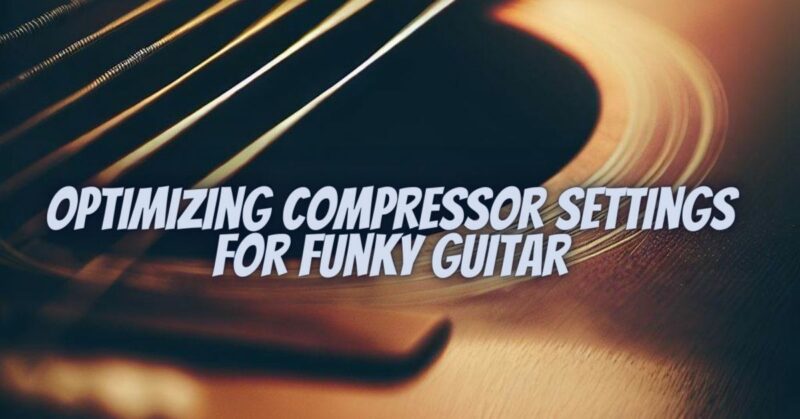Funky guitar playing is all about groove, rhythm, and a tight, percussive sound that makes people want to move. To achieve that distinctive funk guitar sound, one of the essential tools in your arsenal is a compressor. In this article, we’ll delve into the world of compressor settings specifically tailored to bring out the funk in your guitar playing.
The Role of a Compressor in Funk Guitar
Before we dive into the settings, let’s understand why a compressor is so crucial for funk guitar:
Dynamic Control: Funk guitar playing often involves sharp, percussive attacks followed by quick, muted notes. Compressors help even out these dynamics, ensuring that each note in your funky rhythm playing is consistent in volume and presence.
Sustain: Compressors can enhance the sustain of your guitar, allowing those funky notes to ring out and groove with the rhythm section.
Clarity: By taming the peaks and boosting the quieter notes, a compressor can make your funky guitar parts cut through the mix with clarity and precision.
Optimal Compressor Settings for Funky Guitar
Now, let’s explore the compressor settings that can help you achieve that signature funky sound:
1. Threshold
- Set It Low: Start with a low threshold setting. This means that the compressor will begin to kick in even at a relatively low input signal. Funk guitar playing often involves a lot of quick, staccato notes, so you want the compressor to work from the get-go.
2. Ratio
- Moderate Ratio: Choose a ratio between 4:1 and 6:1. This setting ensures that the compression is noticeable but not overly aggressive. You want to maintain dynamics while still controlling the peaks.
3. Attack
- Quick Attack: Set a fast attack time, around 10-20 milliseconds. This allows the compressor to respond swiftly to the initial attack of your funky guitar notes, ensuring that they stay punchy and defined.
4. Release
- Moderate Release: Aim for a release time of 80-120 milliseconds. This setting strikes a balance between allowing the notes to sustain and avoiding excessive pumping or breathing artifacts.
5. Output Level
- Compensate for Gain Reduction: Adjust the output level to match the gain reduction caused by the compressor. This ensures that your overall volume remains consistent when the compressor is engaged.
6. Blend or Mix Control
- Parallel Compression: If your compressor has a blend or mix control, consider using it. Parallel compression allows you to mix the compressed signal with the dry signal, preserving some of the dynamic range while still benefiting from the compressor’s control.
7. Experimentation
- Tweak and Listen: While these settings serve as a good starting point, don’t hesitate to experiment. Funk guitar playing is diverse, and your specific sound may require some adjustments. Trust your ears and make subtle changes to fine-tune your compression settings.
Additional Tips for Funky Guitar Compression
Here are a few extra tips to help you nail that funky guitar tone:
- Use a Clean Amp Setting: Start with a clean amp setting to maintain clarity and articulation in your playing. The compressor will help shape your tone without adding unwanted distortion.
- Watch Your Input Gain: Be mindful of your guitar’s input gain. Too much input signal can overwhelm the compressor and lead to an unnatural sound.
- Practice Your Technique: Ultimately, the funk is in your fingers. Practice muting, percussive strumming, and the staccato accents that define funk guitar playing. The compressor will enhance your technique, but your playing style is key.
- Listen to Funk Guitar Legends: Study the playing of funk guitar legends like Nile Rodgers, Jimi Hendrix, and Prince. Listen to their use of dynamics and compression to gain inspiration and insight.
In conclusion, a well-tuned compressor can be your secret weapon in unlocking the funky potential of your guitar playing. By paying attention to threshold, ratio, attack, release, and other settings, you can sculpt a groove that makes heads bob and feet tap. So, get those settings dialed in, lay down some funky rhythms, and let the groove take over!


